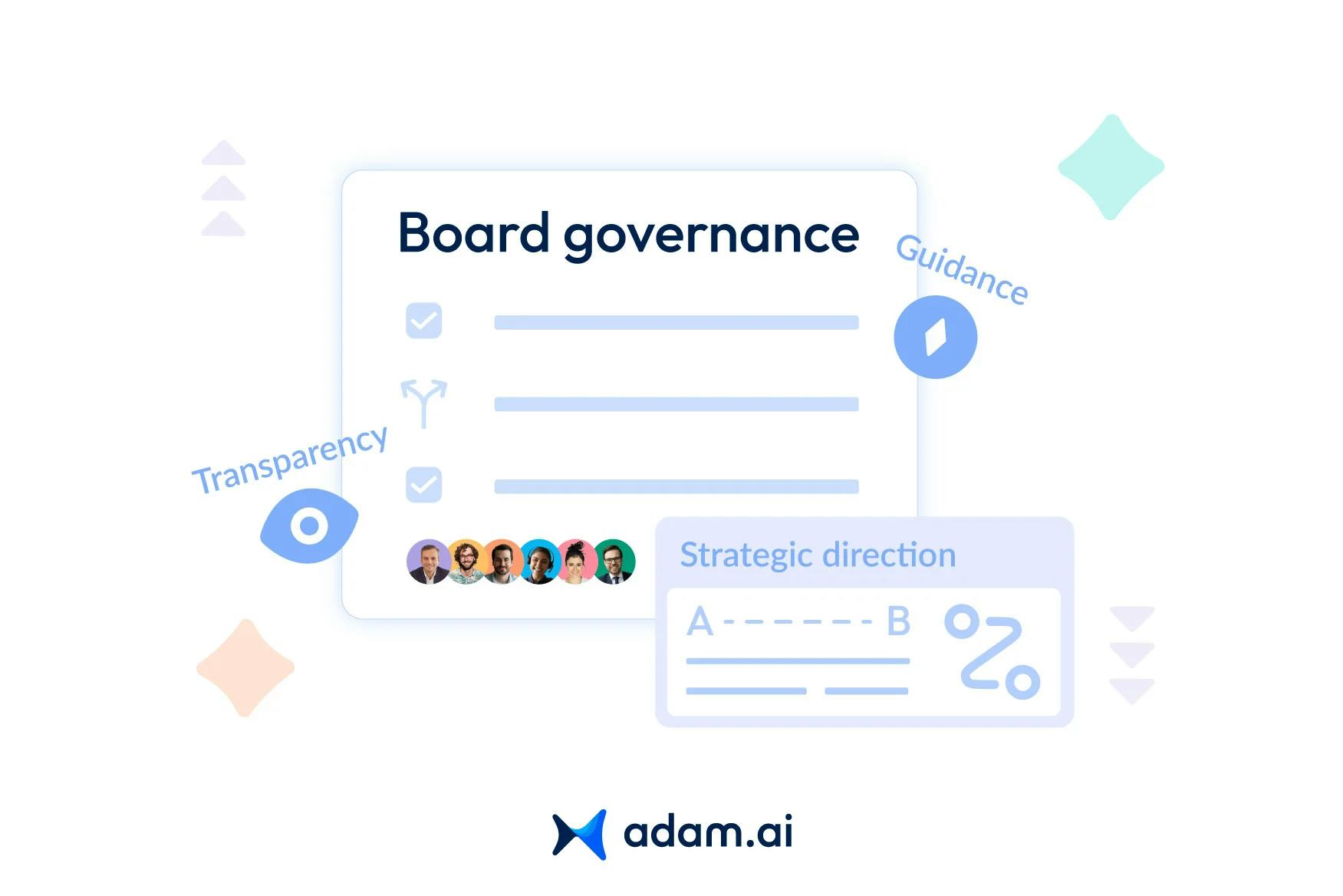Published December 13, 2023
-
13 mins read
The Comprehensive Handbook on Board Governance: Essentials and Beyond

Shaimaa Badawi

In today's corporate world, the concept of board governance stands as a beacon of strategic direction and ethical business conduct.
This article offers an in-depth exploration of board governance, shedding light on its multifaceted nature and the pivotal role it plays in shaping successful, responsible organizations.
We explore how effective board governance goes beyond regulatory compliance to embody strategic leadership, ethical integrity, and operational excellence, so let’s dive in.
What is board governance?
Board governance comprises the mechanisms, practices, and dynamics that guide and regulate a board of directors' management and supervision of an organization. It outlines the roles and responsibilities of the board, establishing a blueprint for their decision-making processes.
This concept emphasizes the balance between directing organizational strategies and monitoring the performance and compliance of the enterprise. It includes ensuring that the organization adheres to legal and ethical standards while pursuing its goals, often with a focus on environmental, social, and corporate governance (ESG) principles.
What does governance mean for a board?
At its core, board governance is about stewardship and accountability. It involves creating a structure that benefits all stakeholders, including shareholders, employees, customers, and the community.
The board is selected to uphold the organization's mission and vision, guiding it toward success while managing risks and adapting to industry trends and changes. The board governance framework also incorporates the evaluation of the board's effectiveness in its oversight role, ensuring that the organization remains aligned with its strategic objectives and values.
Why is board governance important?
Board governance is important for several reasons, acting as the cornerstone of an organization's integrity, stability, and long-term success. Its importance lies in several key areas:
1. Fostering an ethical environment
Robust board governance nurtures an ethical environment throughout the organization. This culture permeates every layer of the company, from routine tasks to high-level strategic choices, guaranteeing that all actions are in harmony with established moral guidelines and the overarching mission of the organization.
2. Ensuring accountability and oversight
Board governance is crucial for holding individuals and teams accountable for their actions. This accountability extends from the executive level down to individual staff members, ensuring that everyone operates within the bounds of established regulations and ethical guidelines.
3. Aligning interests and boosting confidence
Good governance aligns the interests of management with those of external stakeholders. This alignment boosts stakeholder confidence and trust in the organization, which is essential for its long-term viability and success.
4. Risk management and compliance
Board governance plays a critical role in identifying and managing risks, ensuring compliance with laws and regulations. This proactive approach to risk management and compliance helps in avoiding potential pitfalls and legal issues.
5. Driving performance and competitive advantage
Organizations with strong governance are more likely to perform well and have a competitive edge in the market. This is due to efficient, streamlined processes and clear, consistent decision-making frameworks.
6. Facilitating investment and financial stability
Good governance creates formal reporting procedures and transparent operations that are attractive to investors. This transparency and credibility can lead to easier access to capital and financial stability.
7. Providing support and advisory
A well-governed board can offer valuable support and advice in various aspects of business management, from handling financial challenges to making strategic decisions.
8. Enhancing reputation and building trust
Companies that practice good governance are viewed as responsible and ethical, which enhances their reputation and builds trust with customers, investors, and the public.
9. Long-term resilience and success
Finally, good governance lays the groundwork for long-term resilience and success. It helps organizations to adapt to changing environments, leverage emerging opportunities, and sustain their operations over time.
Elevate your board's strategy—download the free guide "The Board Governance Frameworks: Crafting Superior Strategies for Board Directors" now!
What are the governance responsibilities of the board?
The governance responsibilities of a board encompass a comprehensive and multifaceted approach to overseeing an organization's direction, management, and adherence to its goals and ethical standards. Here are the main board governance responsibilities:
- Strategic direction and development: Establishing and guiding the long-term objectives of the organization, formulating corporate strategies, and addressing competitive challenges.
- Leadership oversight: Providing leadership and supervision over the management to ensure effective operation and alignment with the organization’s goals.
- Role delineation: Ensuring a clear division of responsibilities between board leadership (e.g., the chairman) and operational management (e.g., the CEO).
- Stakeholder interests: Acting in the best interests of all stakeholders, including shareholders, employees, and the community.
- Executive appointments and compensation: Playing a role in appointing executives and determining their compensation packages.
- Self-evaluation: Conducting periodic self-evaluations and assessments of board members and committees.
- Compliance oversight: Ensuring adherence to legal, regulatory, and ethical standards, as well as internal bylaws and charters.
- Board member recruitment and selection: Managing the process of board member recruitment, defining roles and qualifications, and making recommendations.
- Risk management: Monitoring and managing risks associated with the organization’s activities and industry.
- Transparency and accountability: Maintaining a framework of accountability and transparency in all board activities and decisions.
What is nonprofit board governance?
Nonprofit board governance refers to the strategic and oversight roles played by a board of directors in a nonprofit organization.
This governance is crucial in steering the organization toward achieving its mission and ensuring long-term sustainability. The board, distinct from the day-to-day management handled by employees and managers, focuses on high-level strategy, oversight, and accountability.
The primary responsibility of a nonprofit board is to make key decisions concerning the organization's direction, goals, and adherence to its mission. This involves acting in the public interest and serving as the legal voice for the nonprofit.
The board's role involves ensuring that the organization operates within the framework of its mission and legal requirements, while also overseeing its financial health and ethical standards.
What are the types of board governance?
Board governance includes various models, each tailored to the specific needs and contexts of different organizations, be they nonprofit or corporate entities. Here's an overview of the key types of board governance.
Nonprofit governance models
- Advisory board model: This model involves the board serving primarily as a consulting body to the CEO, offering expertise and advice. It's commonly used in organizations where the CEO is the founder.
- Patron governance model: This model focuses on fundraising, where board members are influential and financially capable individuals who contribute to and raise funds for the organization.
- Cooperative governance model: It is characterized by consensual decision-making among board members without a CEO, with each member sharing equal responsibility and authority.
- Management team model: In this model, the board forms committees responsible for various organizational functions like HR, fundraising, and finance, similar to a corporate management structure.
- Policy board model: This model involves delegating significant operational control to the CEO, with the board focusing on high-level policy and strategy.
Corporate governance models
- Traditional model: This is an older model where the collective board holds legal responsibility and speaks with one voice on all matters, outlining processes in the bylaws.
- Carver board governance model: This model applies to both nonprofit and for-profit entities, focusing on the end goals of the organization with the CEO having substantial responsibility for achieving these goals.
- Cortex board governance model: It concentrates on the value the organization brings to the community, with the board defining performance standards and outcomes.
- Consensus board governance model: Similar to the cooperative model in nonprofits, this model allows equal voting, responsibility, and liability for all board members and is suitable for corporations without major shareholders.
- Competency board governance model: This model focuses on developing the board members’ skills and knowledge, emphasizing communication and trust to enhance board performance.
Each governance model caters to different organizational structures and needs, emphasizing various aspects like fundraising, policy-making, community value, or board member competency.
The choice of a governance model depends on factors like the organization's size, mission, industry, and stakeholder composition.
These models offer frameworks to ensure effective leadership, strategic direction, and operational oversight, contributing to the organization's overall success and integrity.
What are the 4 pillars of corporate governance?
The four pillars of corporate governance are fundamental principles that guide how companies are directed and controlled, ensuring they operate in a transparent, accountable, fair, and responsible manner. Let's outline the four pillars of corporate governance:
1. Accountability
This pillar emphasizes the importance of being answerable for actions and decisions within a company. It ensures that everyone, from the staff to the leadership, is responsible for their actions, especially regarding risk management and compliance.
Accountability in corporate governance boosts shareholder trust and confidence, as it reassures them that the company operates within its defined boundaries and is prepared to handle future challenges and opportunities.
2. Transparency
Transparency in corporate governance involves clear and open communication about the company's operations, financial performance, and other significant activities.
It requires timely and accurate disclosure of information to shareholders, stakeholders, and the public. Transparent practices enable informed decision-making and build trust, as they allow all actions of the company to be verifiable and accountable.
3. Fairness
This pillar is about equality for all stakeholders, including shareholders, employees, customers, and the community.
Fairness in corporate governance ensures that all parties have their rights protected and are given equal opportunities to participate in and influence the company's decision-making processes. This includes respecting shareholder rights and promoting an inclusive approach to considering the interests of all stakeholders.
4. Responsibility
Responsibility in corporate governance focuses on the company's commitment to act ethically and consider the broader impact of its decisions on society and the environment.
It involves implementing sustainable and ethical practices, respecting human rights, and contributing positively to community welfare. Companies that embrace this pillar are conscious of their social and environmental footprint and strive to maintain a balance between economic growth and societal well-being.
Together, these four pillars form the foundation of effective corporate governance. They ensure that companies not only pursue their business objectives but also maintain a commitment to ethical standards, transparency, accountability, and fairness, which are essential for long-term success and societal trust.
What is the governance structure of a board?
The governance structure of a board is a comprehensive framework that orchestrates and regulates an organization's management and operations.
This structure is designed to ensure that the organization adheres to high standards of integrity, transparency, and efficiency, ultimately making it more competitive and accountable. The key elements of a board's governance structure can be summarized as follows:
- Incorporated board actions: This involves unifying all board functions to avoid inefficiencies and oversights.
- Internal assessments: Regular and thorough internal audits are crucial for providing the board with essential data to make informed decisions and identify risks.
- Compliance with governing standards: Adherence to regulations and standards such as ISO certification is essential, ensuring that all processes and activities are legally and ethically sound.
- Operational and risk management oversight: The board organizes and oversees operational, risk management, and reporting processes, keeping informed about the organization's ongoing activities.
- Strategic planning and decision-making: The framework aids the board in making considered, data-driven decisions and exposes any gaps or weaknesses in the board or management.
- Authority and accountability: The structure brings authority and accountability into the organization, enabling effective decision-making and board oversight.
The governance structure includes various aspects like board and company performance, the communication between the board and executive management, board members’ responsibilities, ethical conduct of the company, risk management, compliance, internal controls, communication strategies, and financial reporting.
What are board governance best practices?
Board governance best practices encompass a range of strategies and policies that ensure the effective oversight and strategic guidance of an organization. Here are some key best practices in board governance:
Diverse and effective board recruitment
It is essential to continually refresh the board with diverse and competent members. This means looking beyond traditional criteria like industry expertise and senior management experience to include diverse perspectives in terms of gender, ethnicity, age, and more. Such diversity enriches decision-making and aligns the board with contemporary economic and social climates.
Structured board composition
The board should comprise a balance of skills, experiences, and independent perspectives. Most governance experts recommend a majority of independent directors to ensure unbiased and holistic decision-making. Regular self-evaluations of the board and its committees are also crucial to identify areas for improvement.
Comprehensive director onboarding
New board members should receive thorough orientation that includes organizational history, policies, legal responsibilities, and current strategic plans. This ensures they are well-prepared to contribute effectively from their first meeting.
Efficient and effective presentations
With increasing responsibilities, board members must receive concise and relevant presentations to make informed decisions. This requires well-structured agendas and clear communication protocols.
Alignment of strategies with organizational goals
Boards should ensure that the organization’s strategies and risk management activities align with its long-term goals. This involves using resources effectively for risk identification and assessment, and ensuring proper risk management frameworks are in place.
Accountability and transparency
Boards need to establish strong internal controls and transparent reporting systems. These systems should include clear performance metrics and regular disclosure practices to foster a culture of accountability.
Ethical leadership and integrity
Board members should exemplify high ethical standards and integrity in their roles. Establishing policies such as conflict of interest guidelines, codes of conduct, and whistleblower policies can support this.
Clear definition of roles and responsibilities
The roles of the board chair and the CEO should be distinct to avoid conflicts of interest. All board members should have clear job descriptions, and responsibilities should be appropriately delegated to various committees.
Accurate financial reporting
Boards must ensure thorough and legal financial reporting. This includes regular, understandable financial reports that provide insight into the organization’s financial health.
Effective communication with stakeholders
Proactively addressing shareholder concerns and maintaining open channels of communication is crucial. This helps in understanding shareholder perspectives and in building collaborative relationships.
Utilization of technology
Embracing technologies like AI is important for staying relevant and efficient. Boards should educate themselves about these technologies to implement them effectively and responsibly.
Independence of the board
Ensuring that board members are sufficiently independent to objectively perform their oversight role is crucial for effective governance.
Limiting conflicts of interest
Boards should establish mechanisms to prevent conflicts of interest and ensure that decisions are made in the best interest of stakeholders.
Subsidiary governance
For organizations with subsidiaries, it’s vital to establish governance frameworks and policies that cascade down to these entities, maintaining consistency in governance practices.
These best practices are not exhaustive but represent key elements that contribute to the effectiveness and integrity of board governance. They help boards navigate complex environments, make informed decisions, and maintain the trust of stakeholders.
Achieve effective board governance with adam.ai
adam.ai is an all-in-one meeting management platform that allows you to capture the knowledge of board meetings and empowers you to run your business through effective meetings in order to achieve good governance.
Here's what you can do with adam.ai:
1. Sync all your calendars on one platform and create unlimited booking pages to show your availability and accommodate the schedules of busy board members.

Screenshot from adam.ai: Booking pages.
2. Record agenda items, actions, polls, decisions, and notes using a smart note-taking system displayed side by side with the built-in video-conferencing feature for enhanced collaboration and productivity, with the ability to integrate with popular video-conferencing tools you're familiar with.

Screenshot from adam.ai: Video call displayed side by side with the meeting content.
3. Choose a customizable meeting agenda template from our gallery to kickstart preparation for your board meetings for maximum productivity.

Screenshot from adam.ai: Meeting templates.
4. Track your actions to ensure task ownership and accountability and improve board decision-making with a powerful follow-up system with the ability to search for actions across all meetings.

Screenshot from adam.ai: Manage actions.
5. Categorize meetings into spaces, including project, team, board, and committee, and have all their content under a specific umbrella for easy access.

Screenshot from adam.ai: Meeting spaces.
6. Generate and share meeting minutes for due diligence in board meetings and to keep a record for future reference.

Screenshot from adam.ai: Meeting minutes.
7. Ask Adam the AI Assistant to generate meeting transcripts, enhance your meeting content, suggest agendas, and highlight action items and key insights.

Screenshot from adam.ai: Adam the Assistant.
Get started right now to experience the true meaning of all-in-one meeting management.
The bottom line
To sum up, board governance stands as a cornerstone of organizational success and ethical conduct. This article has traversed the multifaceted dimensions of board governance, emphasizing its role in fostering a culture of accountability, strategic alignment, and ethical leadership.
To achieve effective board governance, leveraging technology is crucial. We recommend using an all-in-one meeting management platform, like adam.ai, to efficiently manage the entire meeting lifecycle of board meetings.
And while there may be multiple meeting management solutions available, here is why adam.ai is the all-in-one meeting management platform you can trust:
- adam.ai is one of Atlassian Ventures' portfolio companies.
- In the meeting management software category on G2, adam.ai has been ranked a leader and a high performer for successive quarters in the past years.
- adam.ai has been included in the Forrester Report in the AI-enabled meeting technology landscape.
- adam.ai is trusted and used by powerful teams and organizations worldwide for all types of critical meetings, like board, committee, project management, and business development meetings.
- And most importantly, adam.ai integrates with your existing workflow, is SOC2 compliant, provides dedicated support and success, and has a free trial option.
About the author ...
Shaimaa Badawi is an Inbound Marketing Specialist at adam.ai. Her research revolves around meeting management, project management, and board meetings, where she identifies the most daunting meeting pain points that C-level executives, board and committee members, corporate secretaries, and other professionals working in enterprises face in meetings. Based on her findings, Shaimaa provides solutions for inefficient meetings, defines various aspects of corporate-level meetings, and outlines best practices on how to run effective meetings.
Recommended for you

Crafting a Meeting Agenda Based on Robert's Rules of Order
Read now
.png?ixlib=gatsbyFP&auto=compress%2Cformat&fit=max&q=50&w=1350&h=900)
Your Guide to a Successful Board Meeting (For Top Management)
Read now

Chairman vs CEO: Understanding the Distinct Roles in Corporate Leadership
Read now
Subscribe to our blog
Subscribe to our blog
Get the latest blog posts sent straight to your inbox.
